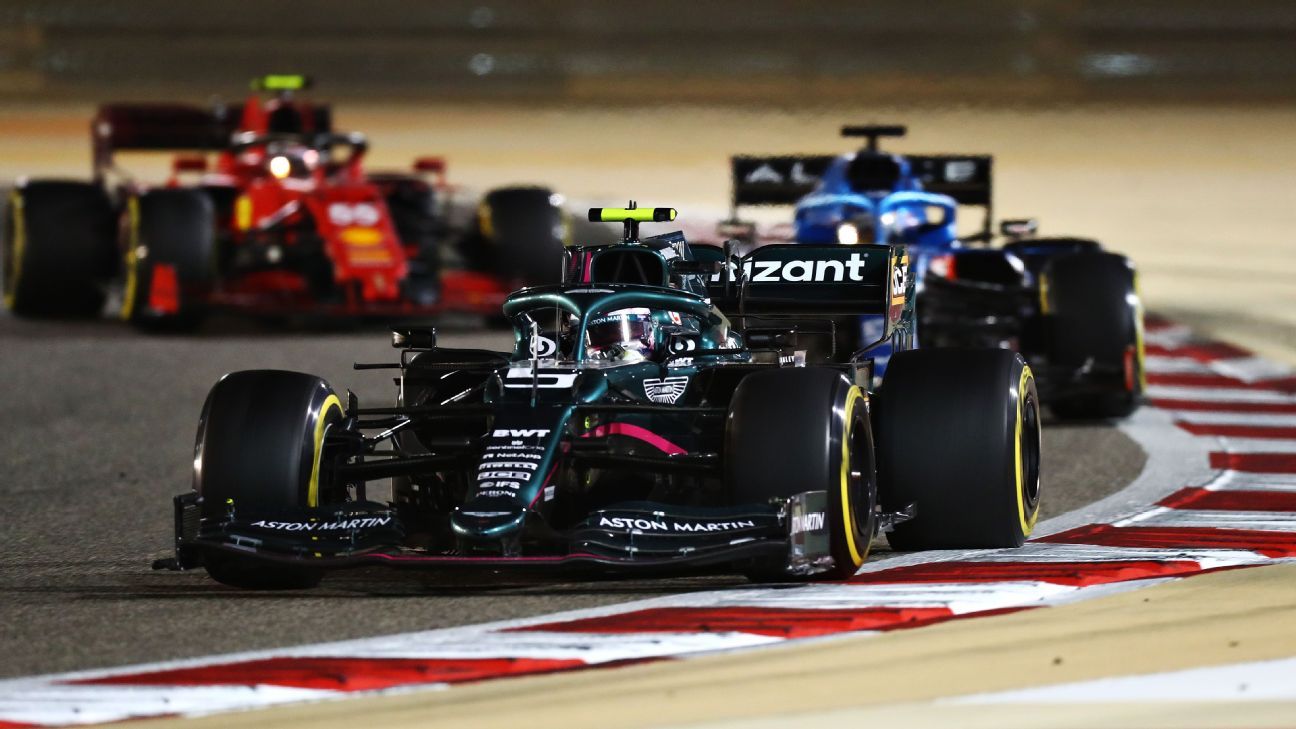The first race of the Formula One season always results in a series of sweeping generalisations about the year to come. Sometimes they hold true, often they don’t.
Now the dust has settled on the Bahrain Grand Prix, ESPN’s Nate Saunders and Laurence Edmondson dissect some of the main talking points from race one.
Aston Martin made a mistake signing Sebastian Vettel
Sebastian Vettel had an awful debut with Aston Martin. The four-time world champion qualified 18th, was demoted to the back of the grid and collided with Esteban Ocon on his way to a 15th-place finish in the race. That incident, and failing to slow for yellow flags in qualifying, meant he collected five penalty points in the first weekend.
So, has Aston Martin made a mistake in signing the four-time champion?
Verdict: OVERREACTION
The narrative coming into this year was that Vettel needed the move to Aston Martin. His Ferrari career had been so promising but the last two and a half years, since his infamous crash out of the lead at the 2018 German Grand Prix, were painful to watch.
Those struggles at Ferrari didn’t deter Aston Martin owner Lawrence Stroll. The Vettel signing was a ringing endorsement of Stroll’s grand vision for the team, adding a world champion to a team with championship ambitions.
Surely a change in scenery would help Vettel rediscover his mojo and consign the spins and underpar performances to the past?
The Bahrain Grand Prix was a disaster in that regard. It was just a rotten weekend from start to finish. He qualified out of position and spent much of the race on a very optimistic one-stop strategy in a bid to try and get himself into contention for a points finish.
The Ocon collision was clumsy, too, and Vettel didn’t help himself by suggesting the Frenchman was to blame when that was clearly not the case.
But it’s far too early to say Vettel was not worth the investment. For one thing, he’s driving at a new team and adjusting to a new car and engine — Daniel Ricciardo and Sergio Perez were also slightly off their usual performance levels in their first events in similar scenarios.
Great drivers are allowed to have bad weekends from time to time. Although Vettel’s issue has been that these have far outweighed his good weekends in the recent past.
Whatever you think about Vettel’s time at Red Bull, he’s a four-time world champion and has earned the benefit of the doubt in this situation. If he can quickly move on from his first race in British racing green and come back strongly in the European leg of races we have coming up, hopefully he’ll start to see some of his former self.
If he doesn’t, then this statement will start to look less like an overreaction. But we’re a long way from that just yet.
NS
Yuki Tsunoda is the real deal
There is a real buzz around AlphaTauri rookie Yuki Tsunoda and his Bahrain Grand Prix performance only increased that excitement.
Tsunoda finished ninth, scoring two points, and pulled off a number of impressive overtakes.The pick of the bunch was an outrageously late lunge on Lance Stroll at the beginning of the final lap for ninth position.
So, is he the most exciting F1 rookie since the 2019 class of George Russell and Lando Norris?
Verdict: NOT AN OVERREACTION
Tsunoda looks like a fantastic prospect. His Formula 2 season last year, where he won three races and finished third overall, showed he stays on the right side of the aggressive/rash divide when racing.
His overtakes on Sunday showed the kind of late braking talent Daniel Ricciardo has showcased time and time again. Ricciardo is considered the best of the F1 grid’s late brakers, but the Red Bull driver program seems to have unearthed another candidate for that label.
Of course, Tsuonda is still inexperienced and we can expect lows along with highs this year. Saturday was a good example of Tsunoda’s considerable talent still being unpolished. Tsunoda turned in a great lap in Q1 to finish the opening qualifying session in second position behind Max Verstappen, but it was Italian Grand Prix race winner Pierre Gasly who realised the true potential of the car and qualified in the top five. By comparison, Tsunoda did not make it through Q2 and started lower down the grid than his car should have been.
That is not a major concern though, as it seemed to be a case of inexperience over a flaw in his driving style. On his debut Tsunoda showed his race craft is there — he even had the foresight to mirror Fernando Alonso’s driving for a few corners after passing the Spaniard mid-race — and the qualifying performances will continue to improve with time.
The Tsuonda situation is going to be fascinating to monitor over the next few years. Given how both Pierre Gasly and Alex Albon have failed to cement their place in the senior team after impressive early stints at the junior outfit, Red Bull may decide to err on the side of caution with the Japanese rookie. Sergio Perez has been signed to a one-year deal with Red Bull as Max Verstappen’s teammate and it seems logical the team will continue with him until it feels Tsunoda is ready for the elevation.
NS
Nikita Mazepin is not ready for Formula One
Nikita Mazepin spun four times on his Formula One debut weekend. The final one of those was on the third corner of the race, spinning out on his own and crashing into the wall.
Going into the next race at Imola, Mazepin has completed more formation laps (there were two on Sunday) than actual F1 grand prix laps (zero).
So, would he have benefited from another year in Formula 2?
Verdict: NOT AN OVERREACTION
This verdict has nothing to do with the off-track controversy which preceded his debut. Speaking to ESPN earlier this year, Mazepin said people should judge him on his on-track performances and he followed that statement up with one of the worst debuts in Formula One’s recent history.
The most concerning thing about the Russian driver’s spins was that they were all unforced errors. On Sunday he admitted he had been too enthusiastic getting back on the throttle after lifting off to avoid contact with teammate Mick Schumacher. His spin in practice and the two which followed in qualifying were also unprompted and appeared to have been caused by similar mistakes.
In preseason testing, Mazepin nearly lost control at the same section of track after underestimating the effect of the turbulent air coming off Antonio Giovinazzi’s Alfa Romeo in front of him. It seems he did not take that lesson into the race.
Mazepin’s teammate, Mick Schumacher, also spun early in the race but managed to avoid ending up with his car in the wall. Schumacher was otherwise error-free and finished the race at the back of the pack, which is as good as it’s likely to get this season for Haas and its backmarking car.
Mazepin has shown flashes of talent in his junior career and won three Formula 2 races last year, but plenty of drivers with more distinguished careers in F1’s feeder series failed to make the step up to the world championship.
Mazepin has 22 races to prove this verdict wrong, but he’s already on the back foot.
NS
Fernando Alonso’s return was a mistake
After the disappointment of his time at McLaren from 2015 to 2018, Fernando Alonso’s return to F1 with Alpine was meant to see him join an improving midfield team.
Yet on the basis of what we saw in Bahrain, Alpine has slipped backwards in the midfield and, while Alonso managed drag the car into Q3 and make a strong start to the race, he ultimately didn’t have the pace to stay in the top ten before retiring.
So, would Alonso be better off watching the 2021 season from his sofa?
Verdict: OVERREACTION
The first year of Alonso’s return was always going to be a transitional one. Like so many teams in the midfield, Alpine is targeting a move up the grid next year under F1’s major regulation change, but it also has a number of factors working against it this year that were always going to make the 2021 season a struggle.
First off, Alonso is racing a three-year old chassis. The Alpine A521 shares its basic underpinnings with the Renault that first raced in the 2019 season. That’s because the team found itself caught in a developmental holding pattern as a result of the delay in F1’s regulation overhaul to 2022 and cost-saving measures for 2021.
At the start of 2020, Renault decided to continue with its 2019 car so it could dedicate more resources to the new regulations, which were originally slated for 2021. Then the pandemic happened and not only were the new rules delayed by a year, but teams were also forced to carry their chassis designs from 2020 to 2021 to cut costs.
What’s more, Renault is the only engine manufacturer that has not brought a major update to its engine this year. Again, the French brand is putting all its chips on 2022, which will also be the last opportunity to rethink the current engines before a freeze in development comes into play.
Therefore, it is no surprise that Alpine has lost momentum relative to its midfield rivals.
But that won’t stop Alonso from dragging the best out of the car this year, and his P9 grid slot was a statement of intent from the two-time world champion. He appeared to push his tyres over the limit in trying to keep pace with McLaren and Ferrari in the opening stint of the race, but that knowledge of the Pirelli’s rubber will now be stored away in Alonso’s head for use at the next race.
It looks like podiums might be out of reach for Alonso on his return, and points finishes could even be a struggle, but the validation (or otherwise) of Alonso’s return to F1 will lie in 2022.
LE
Red Bull has the fastest car
Max Verstappen’s 0.388s advantage over Lewis Hamilton in qualifying supported claims throughout preseason testing that Red Bull and Mercedes have traded places at the front of the grid.
The race offered a counter punch to that statement, demonstrating that a combination of Lewis Hamilton behind the wheel and a good strategy on the pit wall could give Mercedes the edge, but it was clear throughout the 56 laps that Verstappen had the faster car.
So, does Red Bull have the fastest car on the grid for the first time since 2013?
Verdict: NOT AN OVERREACTION
The hype is real. It’s true we only have evidence from one circuit (which is by no means representative of a 23-race calendar) but Red Bull held an advantage over Mercedes in every type of corner at the Bahrain International Circuit.
That’s not to say Mercedes can’t catch up, but in a season where budgets and aerodynamic testing are capped than ever before, having a head start is extremely valuable for Red Bull.
Mercedes believes its main weakness lies in high-speed corners, but also admitted it lost lap time to Red Bull in Turns 9 and 10, which requires stability while combining heavy braking with cornering. More downforce will help the W12, but up until qualifying Mercedes was still struggling to find a setup that gave a solid handling platform to build upon.
It’s possible Mercedes will struggle less at the upcoming races in Imola and Portimao, but the high-speed nature of both circuits are likely to result in Red Bull retaining an edge. Combined with a significant improvement from Honda, Red Bull has a package capable of winning races and the championship.
LE


